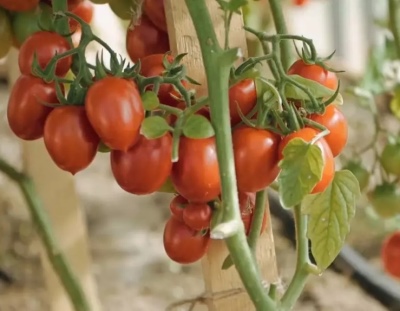
- Authors: Kiramov O.D. (originator: Blokin-Mechtalin V.I.)
- Year of approval: 2018
- Name synonyms: Tiller F1
- Category: hybrid
- Growth type: determinant
- Appointment: fresh consumption, for pickling and preserving, for drying and drying
- Ripening period: early
- Ripening time, days: 90-95
- Growing conditions: for open ground, for film greenhouses
- Marketability: high
Tomato Farmer can become a real gift for any Russian farmer. However, you will have to pay attention to its consumer characteristics. You also need to consider how to grow it and how to care for this plant.
Breeding history
The key developer of the tomato is O.D. Kiramov. The originator of the plant is the well-known Blokin-Mechtalin. The culture was allowed to be used on a large scale since 2018.
Description of the variety
The farmer belongs to the determinant category. It can be successfully grown both in a regular vegetable garden and in greenhouses under plastic wrap. The height of adult plants varies from 0.8 to 1 m. The bushes look powerful and impressive, they have a lot of leaves. The Tiller's green leaves are moderately long.
The main qualities of the fruit
From the very beginning, they are characterized by a light green color. These berries belong to the cherry group. Their mass is 0.02-0.03 kg. Tomatoes are round in shape, have poorly expressed ribs. They are characterized by excellent keeping quality, which pleases farmers.
Taste characteristics
The Tomato Farmer is distinguished by its expressive sweetness. Sourness is mixed with it. In the end, this combination of flavors is perceived quite pleasantly. The pulp is dense. The peel is pleasant to the taste, literally melts when eaten.
Ripening and fruiting
This tomato ripens quite early. Its ripening period ranges from 90 to 95 days. The countdown starts from the formation of the earliest green shoots.
Yield
The variety is one of the high-yielding crops. The collection per 1 m2 can be from 7.5 to 8.4 kg. Such achievements are possible only with competent agricultural technology. According to other sources, 10-12 kg of berries per 1 sq. m.
The timing of planting seedlings and planting in the ground
Sowing seeds for seedlings is usually done in the first decade of March. Seedlings need systematic feeding. As a rule, the readiness of container plants is achieved 50-65 days after the emergence of green shoots.

Growing tomato seedlings is an extremely important process, because it largely depends on whether the gardener can harvest at all. All aspects must be taken into account, from seedbed preparation to planting in the ground.
Landing scheme
Usually a 500x500 mm system is used. For 1 sq. m there should be no more than 4 plants. It is even better to plant a smaller one in order to simplify the care of the plantings. It is necessary to form the bushes in 3, 4 or 5 stems.

Growing and caring
Tomato The farmer must be shaped. It is recommended to saturate the beds with humus mixed with ash. With a strong soil depletion, it is saturated with complexes of mineral fertilizers. They are supplemented with organic feeds. Irrigation should be abundant, but not excessive - both drainage and overflow are dangerous for the plant.
A too humid environment often provokes the appearance of fungal infections. As with watering other varieties, the water must be poured at the root. Getting it on the trunk and leaves is unacceptable. It must be remembered that the tomato Farmer will have to be harvested as quickly as possible. Its fruits can fall off if left on the branches for any length of time.
Preventive treatments are strictly required. Top dressing is applied by root or foliar method. After the lower fruits have ripened, the corresponding leaves must be removed. They do not play a practical role, but they interfere with air circulation. You can't do without a garter on the supports.




A plant needs different micronutrients at each stage of growth. All fertilizers can be divided into two groups: mineral and organic. Folk remedies are often used: iodine, yeast, bird droppings, eggshells.
It is important to observe the rate and period of feeding. This also applies to folk remedies and organic fertilizers.
Disease and pest resistance
Insect pests specific to this variety have not been described. The plant tolerates:
- late blight;
- cracking of fruits;
- verticillosis;
- tobacco mosaic virus;
- other viral diseases;
- fusarium wilting.


Growing regions
The Tomato Farmer is zoned for:
- Western and Eastern Siberia;
- Ural;
- Volga region;
- Far Eastern, Moscow region and other lands.
Review overview
Although the plant is determinant, its bushes develop more than one would expect. Even in cramped greenhouses, these tomatoes grow very efficiently. Gardeners faced with such a plant approve of its use. There are no problems in terms of yield and taste. There will be hardly any more difficulties in growing than with other well-known varieties.

























































































